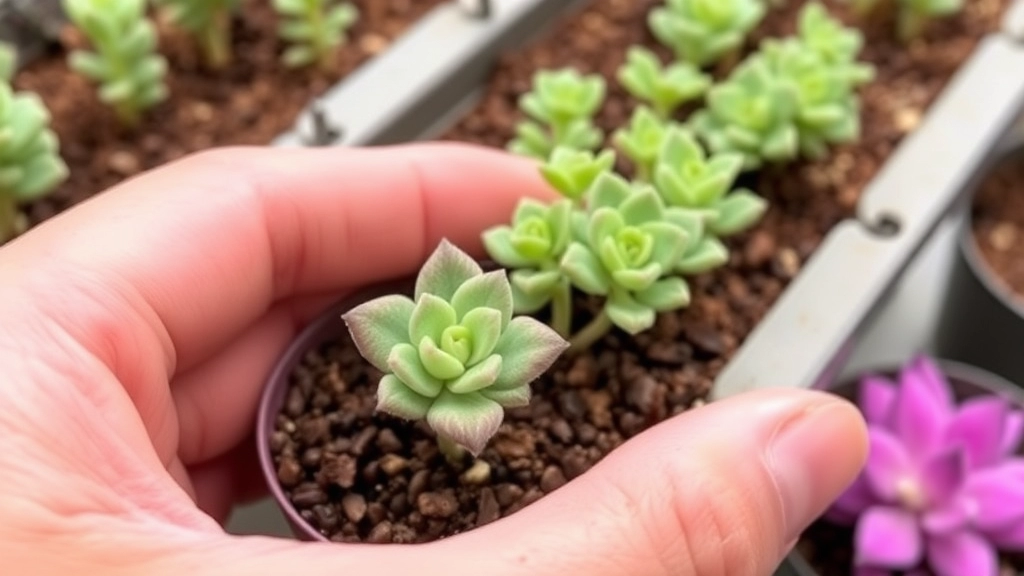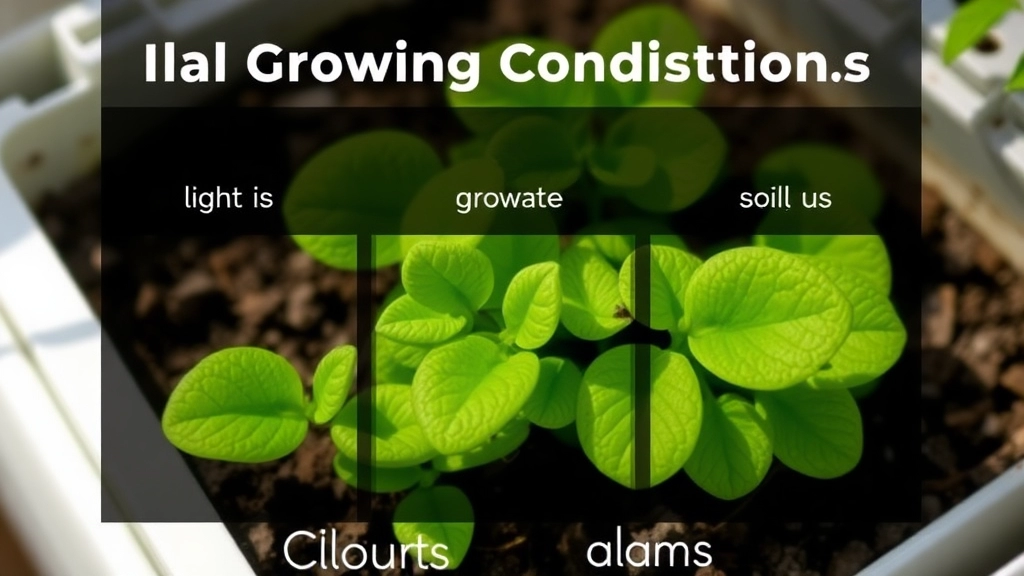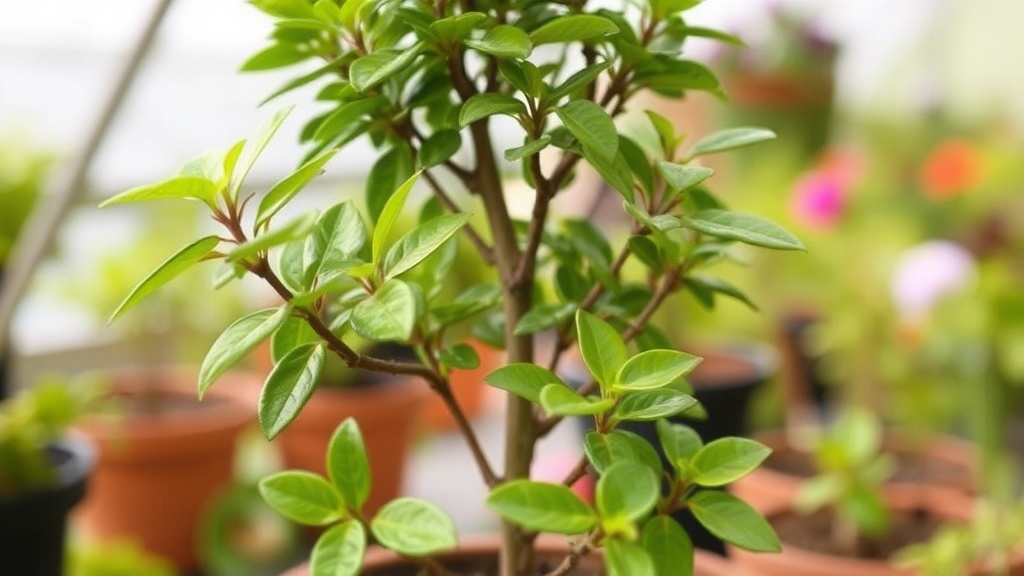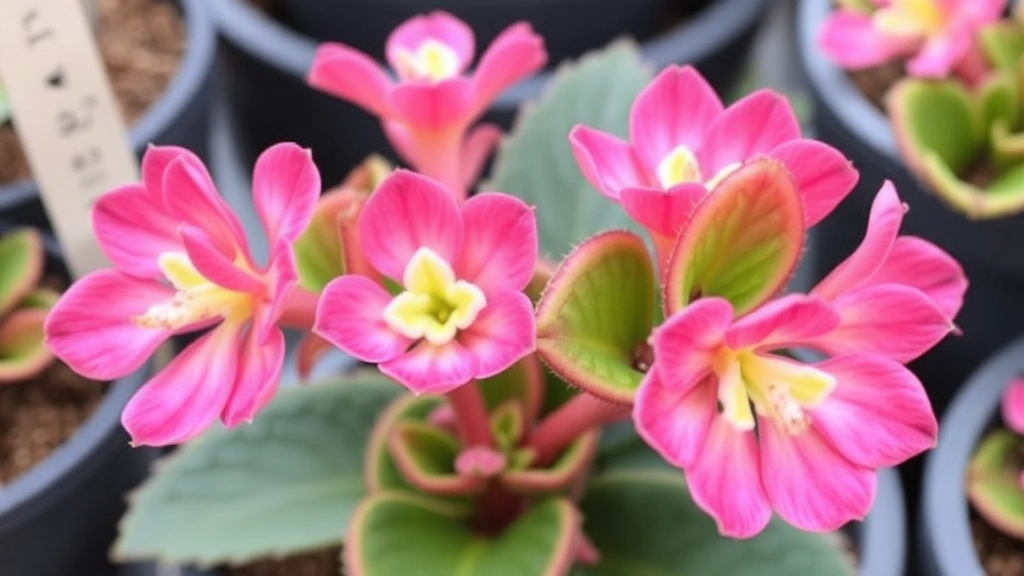Growing Kalanchoe Delagoensis Mother of Millions
If you’re looking to grow a Kalanchoe Delagoensis Mother of Millions, you’re in for a treat. This unique succulent, known for its ability to produce plantlets on its leaves, is both fascinating and easy to care for. To ensure your Mother of Millions thrives, it’s crucial to understand its light, water, and soil needs. This plant loves bright, indirect sunlight and well-draining soil. Be careful not to overwater, as this can lead to root rot.
Propagation
Propagation is one of the most exciting aspects of Kalanchoe Delagoensis. Simply place the plantlets that fall from the leaves onto moist soil, and they will take root quickly. However, be mindful of its invasive nature. Regular pruning and careful management are essential to keep this succulent from overtaking your garden.
Safety Precautions
Additionally, it’s important to note that this plant is toxic to pets and humans, so keep it out of reach of curious hands and paws.
Light Requirements
Kalanchoe Delagoensis thrives in bright, indirect light.
- Ideal Location: Place it near a window where it can soak up the sun, but avoid harsh, direct sunlight that can scorch its leaves.
- Signs of Insufficient Light: If the leaves start to stretch or turn pale, it’s a sign your plant needs more light.
Watering Guidelines
Watering is a crucial aspect of Kalanchoe care.
- Frequency: Allow the top inch of soil to dry out completely before watering again.
- Method: Water deeply, ensuring excess water drains out to prevent root rot.
- Seasonal Adjustments: Reduce watering in the winter months when the plant is dormant.
Soil and Potting
Choosing the right soil and pot is vital for the health of Kalanchoe Delagoensis.
- Soil Type: Use a well-draining cactus or succulent mix to ensure proper aeration.
- Pot Selection: Opt for pots with drainage holes to prevent water accumulation.
Fertilising
While Kalanchoe doesn’t require heavy feeding, a little boost can help.
Propagation Tips for Mother of Millions

So, you’re keen to propagate your Kalanchoe Delagoensis, also known as Mother of Millions?
You’re in for a treat! This plant is not just easy to care for; it’s a champion when it comes to multiplying itself.
Why Propagate?
You might be wondering why you should propagate.
Well, it’s a great way to expand your plant collection or share with friends. Plus, it’s super satisfying to see those little babies sprout!
How to Propagate
Here’s a straightforward guide to get you started:
- Leaf Cuttings:
- Snip a healthy leaf from the parent plant.
- Let it dry for a day or two to form a callus.
- Place it in well-draining soil and water lightly.
- Offsets:
- Look for tiny plantlets around the base of the mother plant.
- Gently twist or cut them off.
- Plant them in their own pots with a mix of cactus soil.
- Seeds:
- Collect seeds from the flowers if they bloom.
- Sow them in a seed tray with a light soil mix.
- Keep them moist and in indirect light until they germinate.
Tips for Success
- Timing: Spring is the best time to propagate. The plant is waking up and ready to grow.
- Humidity: If you can, create a mini greenhouse effect by covering the pots with plastic wrap until you see growth.
- Patience: It might take a few weeks for roots to develop, so hang in there!
Common Pitfalls
- Overwatering: This is a biggie. Make sure the soil dries out between waterings.
- Too Much Sun: While Kalanchoe loves light, direct scorching sun can stress young plants.
Managing the Invasive Nature of Kalanchoe Delagoensis
When caring for Kalanchoe Delagoensis, it’s crucial to address its invasive characteristics. Many plant enthusiasts are often concerned about how to manage this aggressive grower.
Understanding Invasiveness
Kalanchoe Delagoensis, commonly known as Mother of Millions, is notorious for its rapid spread. Its ability to produce numerous offsets can lead to overcrowding in gardens or indoor spaces.
Effective Management Strategies
To keep this plant in check, consider the following strategies:
- Regular Monitoring: Keep an eye on its growth. Check for new offsets regularly.
- Containment: Use pots with drainage holes to limit root expansion. Raised beds can also help control its spread.
- Physical Removal: If you notice unwanted growth, remove the offsets by hand. Ensure you wear gloves, as the plant can be irritating to the skin.
- Mulching: Apply a layer of mulch around the plant to suppress unwanted seedlings and reduce their chances of taking root.
- Limit Fertilization: Over-fertilizing can encourage more vigorous growth. Use a balanced fertilizer sparingly.
By implementing these strategies, you can enjoy the beauty of Kalanchoe Delagoensis without it taking over your space. For more detailed care tips, check out our Mother of Millions care guide and learn about Kalanchoe plant toxicity to keep your household safe.
Ideal Growing Conditions: Light, Water, and Soil Needs

When caring for Kalanchoe Delagoensis, understanding its ideal growing conditions is crucial for its health and vitality. Many plant enthusiasts often wonder about the best environment for their Mother of Millions.
Light Requirements
Kalanchoe Delagoensis thrives in bright, indirect sunlight. Here’s what you should consider:
- Direct Sunlight: Too much direct sunlight can scorch the leaves.
- Filtered Light: A spot near a window with filtered light is perfect.
- Artificial Light: If natural light is limited, consider using grow lights.
Watering Needs
Watering is a delicate balance for Kalanchoe Delagoensis. Overwatering can lead to root rot, while underwatering can cause stress.
- Soil Drying: Allow the top inch of soil to dry out before watering.
- Watering Frequency: Typically, watering every 2-3 weeks is sufficient, but adjust based on humidity and temperature.
- Signs of Stress: Yellowing leaves may indicate overwatering, while shrivelling leaves point to underwatering.
Soil Preferences
The right soil mix is essential for optimal growth. Kalanchoe Delagoensis prefers well-draining soil. Here’s how to achieve that:
- Cactus Mix: A commercial cactus or succulent mix works well.
- DIY Mix: Combine potting soil with sand or perlite for enhanced drainage.
- pH Level: Aim for a slightly acidic to neutral pH (around 6.0 to 7.0).
By ensuring your Kalanchoe Delagoensis has the right light, water, and soil, you set the stage for a thriving plant.
As you nurture your Kalanchoe Delagoensis, you may encounter several common issues that can affect its health and appearance. Understanding these challenges is key to ensuring your plant thrives.
**Pests**
Pests can be a significant concern for Kalanchoe Delagoensis. The most common culprits include:
– **Aphids**: These tiny insects suck sap from the leaves, causing them to curl.
– **Mealybugs**: Recognisable by their white, cottony appearance, they can lead to sticky residue on the leaves.
– **Spider Mites**: Often found in dry conditions, they create fine webs and cause leaf discolouration.
**Solutions**:
– **Aphids**: Spray a mixture of water and mild soap directly on the affected areas.
– **Mealybugs**: Use a cotton swab dipped in alcohol to remove them manually.
– **Spider Mites**: Increase humidity around the plant and spray with insecticidal soap.
**Diseases**
Kalanchoe Delagoensis can also fall prey to various diseases, primarily due to overwatering or poor air circulation.
– **Root Rot**: Caused by overly wet soil, leading to blackened roots.
– **Fungal Infections**: These can manifest as spots on the leaves.
**Solutions**:
– **Root Rot**: Ensure the pot has good drainage and allow the soil to dry out between waterings.
– **Fungal Infections**: Remove affected leaves and apply a fungicide if necessary.
**Leggy Growth**
Leggy growth is another common issue, often resulting from insufficient light.
**Signs**:
– Stems become elongated and weak, with fewer leaves.
**Solutions**:
– **Increase Light**: Move your plant closer to a window or supplement with grow lights.
– **Prune Regularly**: Trim back leggy stems to encourage bushier growth. For more detailed guidance, you can check out our tips on [fixing etiolated Kalanchoe Blossfeldiana](https://planthq.org/fixing-etiolated-kalanchoe-blossfeldiana-lighting-and-care-tips/).
Additionally, if you’re looking to expand your collection with vibrant varieties, explore some [top Kalanchoe succulent varieties and care tips](https://planthq.org/top-kalanchoe-succulent-varieties-and-care-tips/).
VI. Pruning and Repotting Best Practices

So, you’ve got your Kalanchoe Delagoensis thriving, but how do you keep it looking its best? Pruning and repotting are essential steps to ensure your Mother of Millions remains healthy and vibrant.
Why Prune?
Pruning isn’t just about aesthetics; it’s about plant health. Here’s why you should consider it:
- Promotes Growth: Regularly trimming back leggy growth encourages bushier, more compact plants.
- Prevents Overcrowding: Removing excess leaves helps improve air circulation, reducing the risk of pests and diseases.
- Controls Size: If your Kalanchoe is getting a bit too big for its boots, a good prune can rein it in.
When to Prune?
- Spring: This is the best time to give your plant a good trim as it enters its growing season.
- After Flowering: If your plant has bloomed, give it a tidy-up to encourage new growth.
How to Prune?
- Use Clean Tools: Always use sharp, clean scissors or pruning shears to avoid introducing pathogens.
- Cut Above Nodes: Make your cuts just above a leaf node to promote new growth.
- Remove Dead or Yellow Leaves: These can be a sign of stress and can detract from your plant’s appearance.
Repotting: When and Why?
Now, let’s talk about repotting.
- Signs Your Plant Needs Repotting:
- Roots are poking out of the drainage holes.
- Water isn’t soaking in properly.
- The plant appears top-heavy.
- Best Time to Repot: Spring is again your best bet, as the plant is gearing up for growth.
How to Repot?
- Choose the Right Pot: Ensure it’s slightly larger than the current one and has good drainage.
- Use Fresh Soil: A well-draining cactus mix is ideal for Kalanchoe Delagoensis.
- Remove Gently: Carefully take the plant out of its old pot, loosening the roots if necessary.
- Place and Fill: Position the plant in the new pot, fill with soil, and water lightly.
Remember, a well-pruned and repotted Kalanchoe will not only look great but thrive in its environment.
Toxicity Concerns: Safety for Pets and Humans
As we continue our exploration of Kalanchoe Delagoensis, it’s crucial to address a significant concern that many plant enthusiasts have: toxicity.
Is Kalanchoe Delagoensis safe for pets and humans?
The short answer is no. This plant, commonly known as Mother of Millions, contains compounds that can be harmful if ingested.
Key Toxicity Points:
- For Pets:
- Symptoms of ingestion may include vomiting, diarrhoea, and lethargy.
- Cats and dogs are particularly susceptible, so keeping this plant out of their reach is essential.
- For Humans:
- While not typically fatal, ingestion can lead to gastrointestinal distress.
- Children may be more vulnerable, as they often explore their environment by tasting.
Safety Measures:
- Location:
- Place Kalanchoe Delagoensis in areas that are inaccessible to pets and children.
- Education:
- Educate family members about the plant’s toxicity.
- Use clear signage if necessary to remind everyone to keep their distance.
- Alternatives:
- If you’re looking for pet-friendly plants, consider options like spider plants or Boston ferns.
Understanding these toxicity concerns can help you enjoy your Kalanchoe Delagoensis while keeping your loved ones safe. For more details on how to care for this plant, check out our Complete Guide to Caring for Kalanchoe Mother of Millions Plant. Additionally, if you’re interested in other Kalanchoe varieties, don’t miss our Top Kalanchoe Varieties with Pink Edges.
FAQs on Kalanchoe Delagoensis (Mother of Millions)
What is Kalanchoe Delagoensis?
Kalanchoe Delagoensis, commonly known as Mother of Millions, is a succulent plant known for its prolific propagation abilities and easy care requirements.
Why should I propagate my Mother of Millions plant?
Propagation allows you to expand your plant collection, share with friends, and enjoy the satisfaction of seeing new plants grow from your efforts.
What are the methods to propagate Kalanchoe Delagoensis?
You can propagate Kalanchoe Delagoensis through leaf cuttings, offsets, and seeds. Each method has its own steps and requirements.
When is the best time to propagate Mother of Millions?
Spring is the ideal time for propagation as the plant is naturally gearing up for a period of growth.
What are the light requirements for Kalanchoe Delagoensis?
Kalanchoe Delagoensis thrives in bright, indirect sunlight. Too much direct sunlight can scorch the leaves, so a spot with filtered light is ideal.
How often should I water my Mother of Millions plant?
Allow the top inch of soil to dry out before watering. Typically, watering every 2-3 weeks is sufficient, but this can vary based on humidity and temperature.
What type of soil is best for Kalanchoe Delagoensis?
A well-draining soil mix is essential. A commercial cactus or succulent mix works well, or you can create your own by combining potting soil with sand or perlite.
Why should I prune my Kalanchoe Delagoensis?
Pruning promotes growth, prevents overcrowding, and controls the size of the plant. It also helps in maintaining the plant’s health and appearance.
When is the best time to prune my Mother of Millions?
Spring is the best time to prune, as the plant is entering its growing season. You can also prune after the plant has finished flowering.
How do I know if my Kalanchoe Delagoensis needs repotting?
Signs that your plant needs repotting include roots poking out of the drainage holes, water not soaking in properly, and the plant appearing top-heavy.
What is the best time to repot my Mother of Millions?
Spring is the best time to repot, as the plant is gearing up for a new growth cycle.
How do I properly repot my Kalanchoe Delagoensis?
Choose a slightly larger pot with good drainage, use fresh well-draining soil, carefully remove the plant from its old pot, and place it in the new pot. Fill with soil and water lightly.
What are common pitfalls to avoid when caring for Kalanchoe Delagoensis?
Avoid overwatering, which can lead to root rot, and too much direct sunlight, which can stress young plants. Both can negatively impact the health of your plant.
How can I create optimal growing conditions for my Mother of Millions?
Ensure your plant has bright, indirect light, a well-draining soil mix, and a balanced watering schedule. These conditions will help your Kalanchoe Delagoensis thrive.
References
-
Mother of Millions Propagation Tips
-
How to Care for Kalanchoe Delagoensis
-
Kalanchoe Delagoensis: Complete Care Guide
